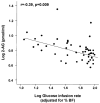Dysregulation of the peripheral and adipose tissue endocannabinoid system in human abdominal obesity
- PMID: 17065342
- PMCID: PMC2228260
- DOI: 10.2337/db06-0812
Dysregulation of the peripheral and adipose tissue endocannabinoid system in human abdominal obesity
Abstract
The endocannabinoid system has been suspected to contribute to the association of visceral fat accumulation with metabolic diseases. We determined whether circulating endocannabinoids are related to visceral adipose tissue mass in lean, subcutaneous obese, and visceral obese subjects (10 men and 10 women in each group). We further measured expression of the cannabinoid type 1 (CB(1)) receptor and fatty acid amide hydrolase (FAAH) genes in paired samples of subcutaneous and visceral adipose tissue in all 60 subjects. Circulating 2-arachidonoyl glycerol (2-AG) was significantly correlated with body fat (r = 0.45, P = 0.03), visceral fat mass (r = 0.44, P = 0.003), and fasting plasma insulin concentrations (r = 0.41, P = 0.001) but negatively correlated to glucose infusion rate during clamp (r = 0.39, P = 0.009). In visceral adipose tissue, CB(1) mRNA expression was negatively correlated with visceral fat mass (r = 0.32, P = 0.01), fasting insulin (r = 0.48, P < 0.001), and circulating 2-AG (r = 0.5, P < 0.001), whereas FAAH gene expression was negatively correlated with visceral fat mass (r = 0.39, P = 0.01) and circulating 2-AG (r = 0.77, P < 0.001). Our findings suggest that abdominal fat accumulation is a critical correlate of the dysregulation of the peripheral endocannabinoid system in human obesity. Thus, the endocannabinoid system may represent a primary target for the treatment of abdominal obesity and associated metabolic changes.
Figures






References
-
- Cota D, Marsicano G, Lutz B, Vicennati V, Stalla GK, Pasquali R, Pagotto U. Endogenous cannabinoid system as a modulator of food intake. Int J Obes Relat Metab Disord. 2003;27:289–301. - PubMed
-
- Di Marzo V, Matias I. Endocannabinoid control of food intake and energy balance. Nat Neurosci. 2005;8:585–589. - PubMed
-
- Piomelli D. The molecular logic of endocannabinoid signalling. Nat Rev Neurosci. 2003;4:873–884. - PubMed
-
- Di Marzo V, Bifulco M, De Petrocellis L. The endocannabinoid system and its therapeutic exploitation. Nat Rev Drug Discov. 2004;3:771–784. - PubMed
-
- Williams CM, Kirkham TC. Anandamide induces overeating: mediation by central cannabinoid (CB1) receptors. Psychopharmacology (Berl) 1999;143:315–317. - PubMed
Publication types
MeSH terms
Substances
Grants and funding
LinkOut - more resources
Full Text Sources
Other Literature Sources
Medical

